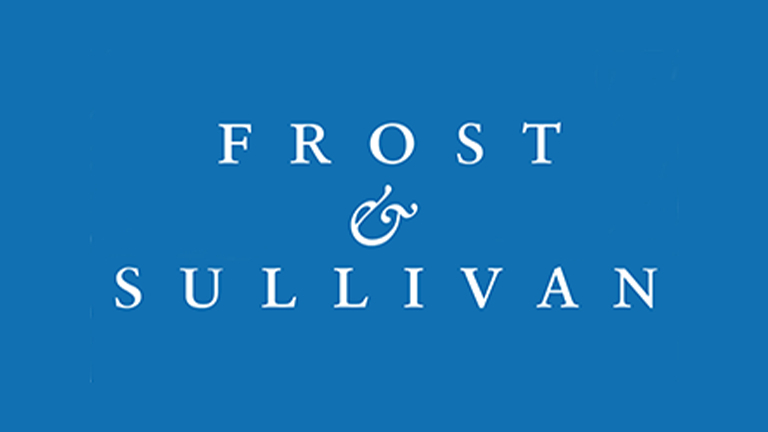

MARK SIMONCELLI
Senior Vice President, Americas Consulting
Frost & Sullivan
STANDING THE TEST OF TIME:
HOW COMPANIES OVERCOME GROWTH OBSTACLES
A Conversation with Mark Simoncelli
With many major publications projecting that much of the S&P 500 will be replaced over the next ten years, there is a clear call to action for organizations today. Disrupt yourself before someone else does. But how?
How can a company best position itself for survival and growth?
This is the central question discussed in board rooms today. Mark Simoncelli, head of Frost & Sullivan’s North American Consulting and Global Strategy and Implementation practices, has guided many business leaders on their quest to find the answer. Simoncelli designed Frost & Sullivan’s growth consulting model – a manual for systematically developing a growth pipeline, evaluating and prioritizing opportunities, implementing go-to-market strategies, and enabling optimization.
As a growth partnership firm, Frost & Sullivan exists to help its clients reach their potential, and over the course of its 57 years in business, the company has pinpointed the set obstacles which often hinder growth.
Common Growth Obstacles
Organizational performance is hamstrung by a combination of factors, but across industries, the following growth obstacles persist:
Limited Insight:
Failing to conduct in-depth research into new opportunities is a potentially devastating strategic mistake. Too many organizations set a strategic course for growth based on opinions instead of data. Without a deep understanding of both market and customer dynamics, poor decision-making, inferior execution, and reduced market share are likely to follow. Simoncelli points to the mistakes made by some major US retailers – that entered European and UK markets without fully assessing those opportunities. According to Simoncelli, “An idea may look or feel right, but if you haven’t properly evaluated the requirements, the complexities, the competition, or what local customers really want, the business will struggle.”
Limited Agility:
Limited agility stems from unresponsive or indifferent internal forces. If an organization has too much bureaucracy or a deeply entrenched status quo rejecting change, its inertia will impede its agility. The organization will be too slow to respond to major market shifts and developments, which will dramatically reduce the likelihood of survival.
Limited Change Management:
Growth can also be hindered by misalignment between the organizational value chain and new opportunities. The process of how an organization changes (e.g., people, processes, technologies, and strategies) must be thoughtfully managed. Simoncelli noted, “Change is never comfortable. It’s fast-paced. It’s disruptive. When adopting a new business model, which many companies will do over the next 10 years, the disruption is far more severe. Management must be prepared to guide their teams through such radical change.”
Limited Clarity:
If the rational for a the pursuit of a new opportunity or strategy cannot be clearly mapped on a single piece of paper, business leaders will have difficulty gaining buy-in across their organization. Often times, companies will fail to answer the “why” questions (e.g., “why is this opportunity critical for our growth”) with a finite number of key metrics, (e.g., people goals, operational goals, learning goals, and financial goals, etc.).
Five Recommendations for Organizational Survival and Growth
Capitalizing on key opportunities for revenue growth is a serious challenge for every company. Today, the process not only requires significant market insights and analysis but also greater organizational resilience and adaptability. For example, market shifts can trigger the need to immediately develop new skill sets or require strategic partnerships to be created for new business models.
By analyzing companies well-equipped to adapt to changing business environments, Simoncelli created the following recommendations for survival:
Generate Competitive Intelligence:
Firms must understand where growth opportunities exist. This requires accurate research, methodical analysis, and thorough planning on future scenarios. Simoncelli says that companies may need to consider opportunities five or ten years ahead in adjacent markets or perhaps even two markets away from their current core operations. Such exploration often leads companies to develop new business models and digitally-driven services by identifying emerging opportunities and leveraging new technologies.
Align on Organizational Agility:
Simply knowing what the most strategically attractive opportunities are is not enough. To survive, an organization must also take action and execute consistent go-to-market strategies in a timely manner. Simoncelli explains the need for agility using a retail example stating, “Consider how the customer is king today. The customer is incorporated into every part of business operations. This shift impacts various organizational components – from people to IT/OT technologies to processes. We see this playing out in retail today. The success of Amazon’s two-day shipping disrupted how other retail players were operating. For example, Walmart had to adopt two-day shipping for its online orders to stay competitive and maintain its market position.”
Become Customer “Obsessed”:
Whether B2B or B2C, growth companies are customer-centric by nature. They start with customer needs and pains, work backward to business requirements, and then adapt their capabilities where necessary. Simoncelli believes companies with a diverse set of skills, including the ability to deliver and sell products as a service, have a distinct advantage in driving future growth.
Embrace Technology:
Because software is almost always a requirement for future opportunities, growth companies are also tech-savvy. According to Simoncelli, “Digital competence is now a prerequisite for not only driving growth, but surviving in most markets. When considering new technologies or business models, it’s important to recognize two things. First, visualize how mega trends (e.g., the societal, financial, technological, and structural forces redefining the future world) are moving. Then, determine how the convergence of such trends will impact your future marketplace.”
Create Resiliency:
In Simoncelli’s mind, resiliency is the cornerstone of organizational growth. He says, “The reality is that it’s very tough to make change. Over time, I’ve seen that many companies tend to reject change. They want to go back to the status quo. An inability to stay the course causes companies to never fully realize a new growth strategy or the execution of a new business model.”
Simoncelli’s survival recommendations apply to both established and emerging industries. Well-known industrial companies, including Emerson and Schneider Electric, are shining examples of organizations investing in their survival by developing diverse skills, digital competencies, and capacities to deliver both great products and services.
The Future of Growth
According to Frost & Sullivan research, tomorrow’s greatest growth opportunities lie in new technology-enabled and service-based business models. “By 2020, 70 percent of all Fortune 500 companies will sell a product as a service. That represents a transformational shift to new business models,” says Simoncelli. “Companies that seek growth through new business model innovations are likely to realize 10 times the return on investment as companies focusing on incremental product or process innovations.” Other avenues for growth (e.g., geographic expansion, acquisitions, and new customer markets) are also accessible. Frost & Sullivan analysis indicates that geographic markets such as Indonesia, Mexico, and Egypt offer growth opportunities for many companies, and new customer markets such as Gen Z and the Women’s Market continue to generate consumer momentum and garner strategic attention from organizations.
However, Simoncelli says, “The future of service-based business models will be about outcomes.” Companies will increasingly be required to deliver on an outcome as a service, rather than a product or even a service as a product. Once a company has access to real-time data and is connected across the value chain, it will have a much greater capacity to impact and guarantee outcomes. Customers will want to do business based on such capabilities. Simoncelli and Frost & Sullivan are seeing this trend across numerous industries, from healthcare, to oil & gas, and beyond. “Customers will increasingly say they’re not willing to pay for a long list of items on an invoice. They say, ‘Guarantee outcomes for our business. Make it easier for us to perform.’”
Conclusion: Prepare for Growth & Change
Business landscapes will continue to evolve, and organizations who are leading today may be trailing tomorrow. However, with the right moves, internal champions, and external partners, organizations can overcome their growth obstacles. Simoncelli tells us, “This is a time of uncertainty, and business leaders must steer their companies with conviction. If you want to know how to best position your company for survival, partner with a guide to help you understand your market and create a plan for future growth.”
